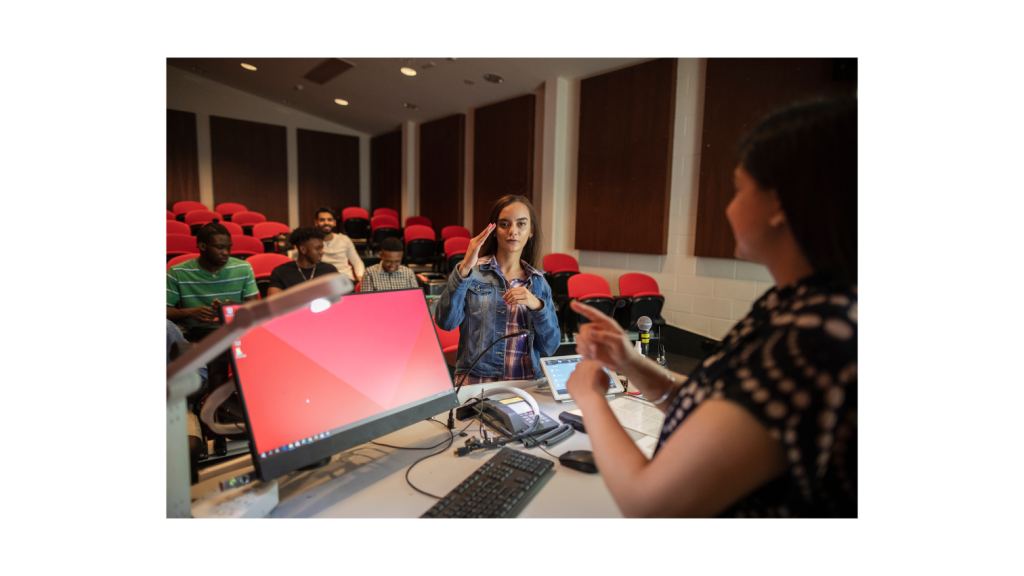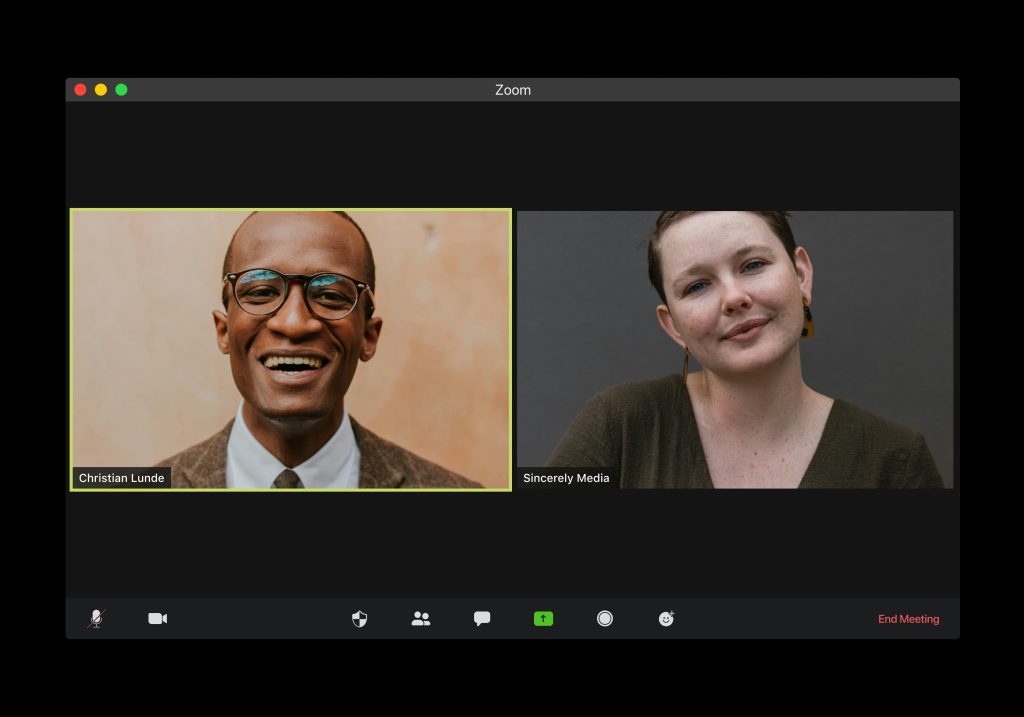ASL for Pre-Recorded Videos: Make Your Content Truly Accessible
Discover the power of on-screen sign language and why it matters more than ever. From overlays to embedded interpreters—here’s how ASL transforms your videos.
Table of Contents
When students with impaired hearing sign up for online courses, they are excited—but also nervous.
As Deaf students, they often face barriers that others don’t even notice. While most videos came with captions, they often missed context, emotion, or visual clarity.
And transcripts? Helpful, sure—but not everyone learns best through reading.
What makes a course different is the moment they see an ASL interpreter appear on screen.
Suddenly, the content comes alive. The interpreter’s expressions, movements, and timing added layers of meaning that captions alone couldn’t convey. For the first time, DHOH students felt fully included—not just accommodated.
This blog explores how services like American Sign Language (ASL) interpretation, embedded video overlays, captioning, and video transcription work together to open access to pre-recorded video content.
For viewers who don’t read, who don’t learn well by reading, or who thrive through visual and kinesthetic communication, these tools aren’t just helpful—they’re essential. Let’s dive into how to make your content truly accessible to everyone.
ASL vs. Captions and Transcripts: More Than Just Words
Captions and transcripts are valuable tools—but they don’t tell the whole story.
Captions give you the words that are being spoken, often in real-time.
Transcripts give you the script after the fact. They’re great for many learners—but for Deaf and hard-of-hearing viewers, they can leave out something important: emotion, nuance, and human connection.
That’s where American Sign Language (ASL) interpretation adds a deeper layer.

The Human Touch: Emotion and Expression
ASL is not just a word-for-word translation of English. It’s a rich, visual language with its own grammar, rhythm, and structure. More importantly, it conveys tone and emotion through body language, facial expressions, and movement—something a caption can’t do.
For example, let’s say a video instructor says,
“This part is really important!”
Captions might only show:
[This part is really important!]
But an ASL interpreter can emphasize important with raised eyebrows, a stronger movement, and focused eye contact.
That physical delivery gives the viewer cues about what to pay attention to—just like hearing people get from changes in voice tone.
Visual Learners and Accessibility
Some Deaf individuals have limited literacy in English. For them, reading captions or transcripts may not be the most effective way to understand content.
Seeing the message in ASL allows them to access it in their native language. That’s powerful—not just for comprehension, but for inclusion and respect.
It also benefits visual learners in general. Watching an interpreter can help retain attention and improve understanding for people who process information better through movement and visuals than through reading.
Biases to Be Aware Of
That said, relying only on ASL has its own limitations:
- Not all Deaf viewers use ASL. Some use other sign languages, and others may prefer captions.
- ASL interpreters bring a human element, which means there can be slight variations in interpretation.
- Some viewers might find the presence of a person in the video distracting if it’s not well-placed or balanced with the content.
That’s why the best approach is often a multi-format experience:
ASL + Captions + Transcripts
This gives viewers options. They can choose the mode that works best for them, or use several at once for better understanding.
ASL Services for Pre-Recorded Content: Overlay or Embed?
Making your pre-recorded videos accessible isn’t just a nice-to-have—it’s essential. Especially for Deaf and hard-of-hearing viewers, having multiple ways to access your content can make all the difference.
Captions help. Transcripts are useful. But sometimes, reading alone doesn’t work for everyone.
Some people need visual language, like American Sign Language (ASL), to fully understand and engage with the content.
In this section, we’ll break down two ways to add ASL to your videos—overlaying and embedding—plus a few other tips to make your content more inclusive for everyone.
Overlay vs. Embedding ASL Interpretation
Integrating ASL interpretation into pre-recorded videos can be achieved through two primary methods: overlaying and embedding.
- Overlaying involves adding a video of an ASL interpreter on top of the original content, typically positioned in a corner. This approach allows viewers to see both the interpreter and the main content simultaneously.
- Embedding refers to permanently incorporating the interpreter’s video into the main video file. This ensures that the ASL interpretation is always available as part of the content, providing consistent accessibility.
While many American universities offer ASL interpretation services and incorporate ASL into their curricula, specific information about the use of ASL embedding or overlaying in pre-recorded videos is limited.
However, they do often provide accommodations such as live interpreters, captioning, and transcription services to support Deaf and hard-of-hearing students.

Enhancing Video Accessibility
Beyond ASL interpretation, several strategies can further improve the accessibility of pre-recorded videos:
Closed Captions and Transcripts
Providing accurate captions and transcripts benefits not only Deaf and hard-of-hearing individuals but also those learning a new language or watching in sound-sensitive environments. Captions should be synchronized with the audio and include non-speech elements like music or laughter to convey the full context.
Audio Descriptions
For viewers with visual impairments, audio descriptions narrate key visual elements of the video, offering a comprehensive understanding of the content.
Accessible Media Players
Use video players that support accessibility features such as customizable captions, keyboard navigation, and screen reader compatibility. This ensures that all users can control playback according to their needs.
High-Contrast Visuals
When adding text on stream, use high-contrast color schemes and legible fonts to assist viewers with low vision or color blindness. Avoid rapid flashing or strobing effects to prevent triggering seizures.
Content creators can make pre-recorded videos more inclusive, aligning with WAI sing language guidelines and ensuring that all viewers, regardless of their abilities, have equitable access to information.

Live ASL Interpretation vs. ASL for Pre-Recorded Videos: What’s the Difference?
Both live and pre-recorded ASL interpretation serve the same goal—making spoken content accessible to Deaf and hard-of-hearing audiences.
But the way they’re delivered (and the challenges they solve) are very different.
Live ASL Interpretation
Live ASL is used in real-time settings: think webinars, virtual meetings, live classes, or conferences.
Benefits:
- Viewers get immediate access to the conversation as it happens.
- It allows for audience interaction—interpreters can translate both directions, including questions or comments from Deaf participants.
- Great for time-sensitive or dynamic virtual events.
Challenges:
- It’s fast-paced. Interpreters must keep up with unscripted speech, which can be demanding and lead to occasional misinterpretation.
- Limited by availability. A skilled ASL interpreter must be scheduled in advance—and not every event can afford one.
- No room for edits or perfect timing.
ASL Interpretation for Pre-Recorded Videos
Pre-recorded ASL is planned, filmed, and edited before being added to the video. It’s often shown in a small window (overlay) or embedded directly into the content.
Benefits:
- Higher quality. Interpreters can rehearse, re-record, and fine-tune delivery for accuracy and clarity.
- Better synchronization with visual cues in the video—pauses, tone changes, and key points can be emphasized more effectively.
- Can be reviewed, reused, and repurposed anytime.
Challenges:
- No live interaction—viewers can’t ask questions or participate in a two-way exchange.
- Requires more production time and planning.
- Needs to be well-placed and styled to avoid blocking important content on screen.
Which One Should You Use?
It depends on your content.
- Live ASL is ideal for interactive, time-sensitive events.
- Pre-recorded ASL is perfect for educational videos, courses, tutorials, or any content that will be used over and over.
Ideally, if you’re offering both live and recorded content, you should provide both options to ensure full access—no matter how someone prefers to engage with your content.
To provide the best possible experience, focus on a few key aspects:
First, ensure accuracy and clarity in all interpretations, transcriptions, and captions.
Second, offer flexible formats, such as live and pre-recorded options.
Third, maintain a user-friendly platform where clients can easily access and customize services.
Lastly, offer excellent customer support to address any questions or needs.
Who Can Use ASL Interpretation for Pre-Recorded Videos? (Hint: It’s Not Just Schools)
When we think about ASL in videos, we often picture classrooms or online courses. But the truth is—so many other organizations can benefit from using ASL interpretation in their pre-recorded content. It’s not just about education. It’s about inclusion.
Here are some real-world examples:
1. Government agencies
From emergency updates to how-to guides for public services, ASL helps ensure Deaf viewers get critical information clearly and quickly. For example, FEMA and CDC often provide sign language overlays for informational videos.
2. Healthcare providers
Need to explain a medical procedure or health tip? Adding ASL makes these videos easier to understand for Deaf patients—especially when captions just aren’t enough. Sign language is especially important for critical health information and consent-related content.
3. Workplaces
Whether it’s training videos for new hires or company updates, ASL interpretation helps make internal content accessible to all employees.
4. Nonprofits and advocacy groups
Spreading awareness or launching a campaign? Including ASL shows your message is meant for everyone, including the Deaf community.
The National Association of the Deaf (NAD) regularly uses ASL for pre-recorded videos to share information pertinent to the Deaf and hard-of-hearing community.
5. Media and entertainment
Music videos, documentaries, YouTube content—adding ASL not only boosts accessibility, it also connects with an often-overlooked audience. Music videos with ASL interpretations are increasingly popular and well-received.
6. Museums and cultural spaces
Virtual tours and exhibit guides become more inclusive when ASL is added. Everyone deserves to enjoy art, history, and culture.
The Smithsonian, with its variety of ASL events, is a true example of an inclusive cultural institution.
7. Religious communities
Sermons, prayers, and community messages feel more welcoming when ASL is part of the experience—online or in person.
8. Conferences
After the event’s over, recordings with ASL help extend your message to a wider audience, including those who couldn’t attend live.
9. Legal and financial services
Explaining legal rights, financial planning, or how to use your services? ASL makes complex info easier to understand and more approachable.
10. Tech companies
If you’ve got how-to videos, product walkthroughs, or customer support content—adding ASL can make your tools accessible to more users.
Can AI Replace Human ASL Interpreters? Not Quite.
With all the talk about AI transforming the world, it’s natural to wonder:
“Can AI do sign language interpretation too?”
The short answer? It’s getting there—but it’s not ready to take over.
What Sign Language AI Can Do (So Far)
Sign language AI is being developed to recognize and generate signs using avatars or computer vision. Some tools can:
- Translate basic English text into signs using animated avatars
- Recognize and interpret some signs through webcam input
- Support learning ASL by modeling how to perform individual signs
It’s impressive technology—but there’s still a long way to go.
What AI Can’t Do (Yet)
Even the most advanced AI struggles with the true depth of human communication in ASL. Here’s why:
- Facial expressions, body language, and emotion are crucial in ASL. AI-generated avatars often lack the subtlety and fluidity needed to make the message feel natural and clear.
- ASL isn’t just a signed version of English—it has its own grammar, structure, and cultural context. AI doesn’t always get those nuances right.
- Context matters. A human interpreter can adapt in real time, clarify meaning, and adjust tone based on the audience or subject matter. AI just can’t replicate that level of dynamic understanding.

Why Humans Still Matter Most
A real ASL interpreter brings more than just language—they bring empathy, presence, and cultural competence. They can:
- Interpret tone, sarcasm, urgency, and emotion
- Read the room and adjust accordingly
- Ensure communication is respectful and accurate in sensitive settings like healthcare, legal proceedings, or education
Bottom Line?
AI is a great tool for support and learning, but not a replacement for human interpreters.
When accessibility matters—especially in pre-recorded videos meant to connect and educate—real people still make the biggest difference.
ASL overlays, embedded interpretation, captions, or transcripts, open the door for deeper understanding, connection, and inclusion.
If you’re creating video content, it’s time to think beyond the default.
Start including ASL interpretation in your videos—and don’t settle for one-size-fits-all solutions.
Ready to make your content accessible to everyone?
Reach out to an experienced ASL interpretation provider and take the first step toward truly inclusive communication!
Our Latest Resources
Request A
Call Back
Request A Call Back
Do you have additional questions?
Click here to meet your dedicated Client Relationship Manager.


